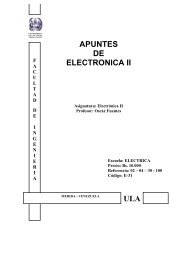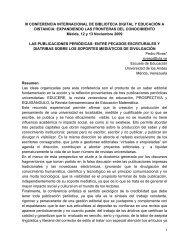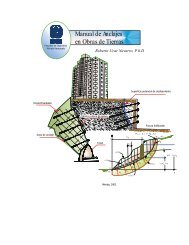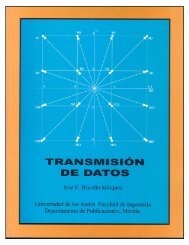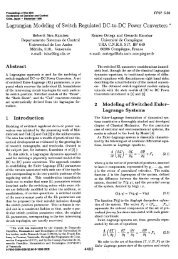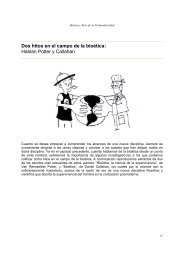Passivity-based Control of Euler-Lagrange Systems:
Passivity-based Control of Euler-Lagrange Systems:
Passivity-based Control of Euler-Lagrange Systems:
You also want an ePaper? Increase the reach of your titles
YUMPU automatically turns print PDFs into web optimized ePapers that Google loves.
Preface<br />
By its own denition the nal purpose <strong>of</strong> control is to control something. In fact,<br />
the foundational developments <strong>of</strong> Huygens, Maxwell, Routh, Minorsky, Nyquist and<br />
Black (to name a few) were motivated by real{world applications. In the hands <strong>of</strong><br />
mathematicians such as Wiener, Bellman, Lefschetz, Kalman and Pontryagin (again,<br />
to name just a few) control theory developed in the 1950s and 1960s as a branch <strong>of</strong>applied<br />
mathematics, independent <strong>of</strong> its potential application to engineering problems.<br />
Some tenuous arguments were typically invoked to provide some practical motivation<br />
to the research on this so{called mathematical control theory. For instance, the<br />
study <strong>of</strong> the triple (A B C) was rationalized as the study <strong>of</strong> the linearization <strong>of</strong> an<br />
arbitrary nonlinear system {an argument that had a grain <strong>of</strong> truth. By the end <strong>of</strong><br />
the 1980s a fairly complete body <strong>of</strong> knowledge for general linear systems {including<br />
powerful techniques <strong>of</strong> controller synthesis{ had been completed. Some spectacular<br />
applications <strong>of</strong> this theory to practical situations that tted the linear systems<br />
paradigm were reported.<br />
The attempt to mimic the developments <strong>of</strong> linear systems theory in the general<br />
nonlinear case enticed many researchers. Extensions to a fairly general class <strong>of</strong> nonlinear<br />
systems <strong>of</strong> the basic concepts <strong>of</strong> controllability, observability, and realizability<br />
were crowned with great success. The controller synthesis problem proved to be,<br />
however, much more elusive. Despite some signicant progress, to date, general techniques<br />
for stabilization <strong>of</strong> nonlinear systems are available only for special classes <strong>of</strong><br />
nonlinear systems. This is, <strong>of</strong> course, due to the daunting complexity <strong>of</strong> the behaviour<br />
<strong>of</strong> nonlinear dynamic systems which puts a serious question mark on the interest <strong>of</strong><br />
aiming at a monolithic synthesis theory. On the other hand, new technological developments<br />
had created engineering problems where certain well{dened nonlinear<br />
eects had to be taken into account. Unfortunately, the theory developed for general<br />
nonlinear systems could not successfully deal with them, basically because the<br />
\admissible structures" were determined by analytical considerations, which do not<br />
necessarily match the physical constraints. It became apparent that to solve these<br />
new problems, the \nd an application for my theory" approach had to be abandoned,<br />
and anewtheory tailored for the application had to be worked out.<br />
The material reported in this book is an attempt in this direction. Namely, we<br />
start from a well{dened class <strong>of</strong> systems to be controlled and try to develop a theory<br />
vii



